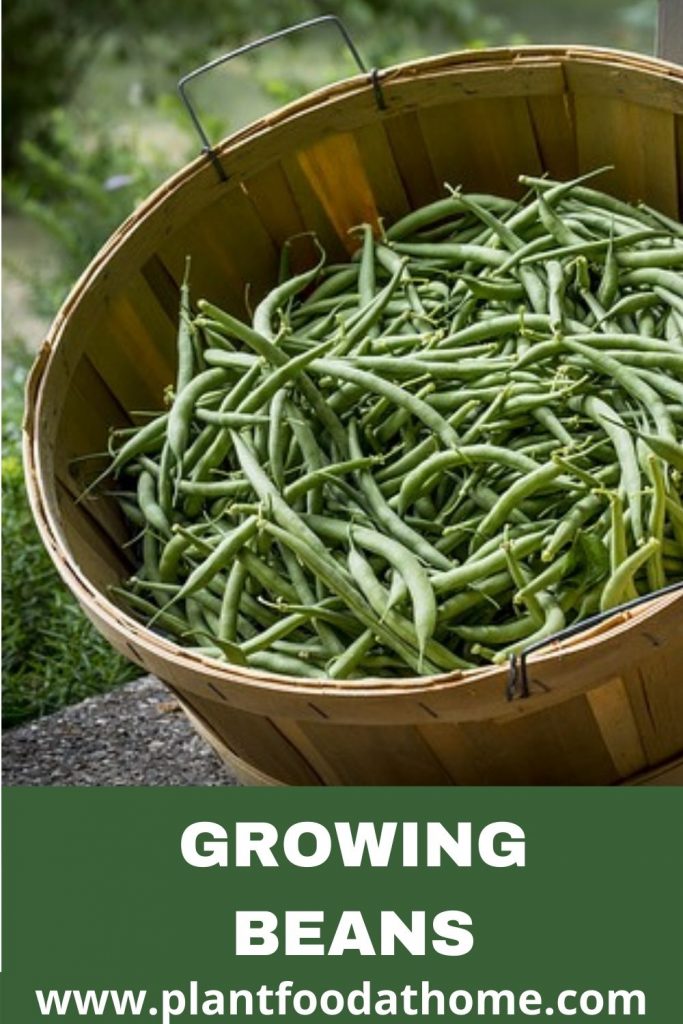Beans come in many varieties, and have been a staple of our food for hundreds, if not thousands, of years. And these delicious vegetables are surprisingly easy to grow. So why not add beans to your own garden? Read on to learn how to grow beans including planting, caring for, and harvesting beans.
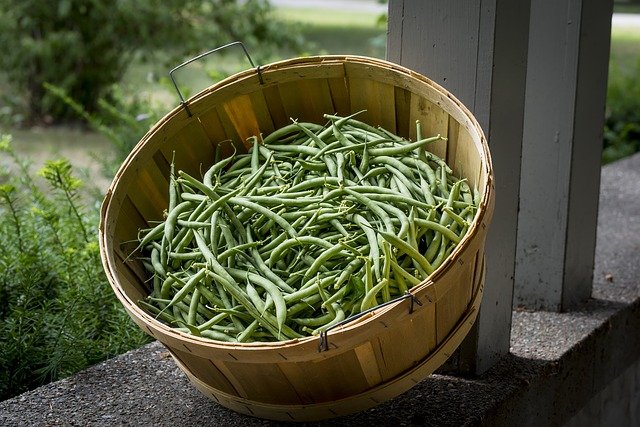
Related: Bean Plants Dying? 7 Causes and Solutions
Table of Contents
Bean Plant Profile
Beans are a group of plants that all belong to the family Fabaceae. There are many different breeds and varieties, but all of them are annuals and are grown in similar ways. The size of plants varies: for bush varieties, they grow in compact bushes around two feet tall (60cm), but pole varieties can vine up to 10 or 15 feet (3-4.5 meters)!
Bean varieties
First, you should know that beans are separated into two varieties:
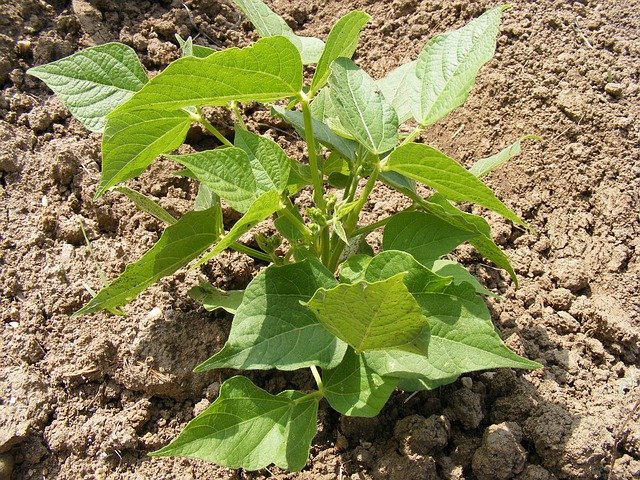
- Bush beans, also called determinate varieties, grow in short, compact bushes that typically reach about two feet (60cm) in height. They take up less space, but also produce less crop.
- Pole beans, also called indeterminate varieties, grow as vines, and therefore need a trellis or other support. These varieties can reach 10 or 15 feet (3-4.5 meters) tall, and tend to produce more of a crop, while also being more resistant to disease. The downside is that they take up much more space, and can be harder to control.
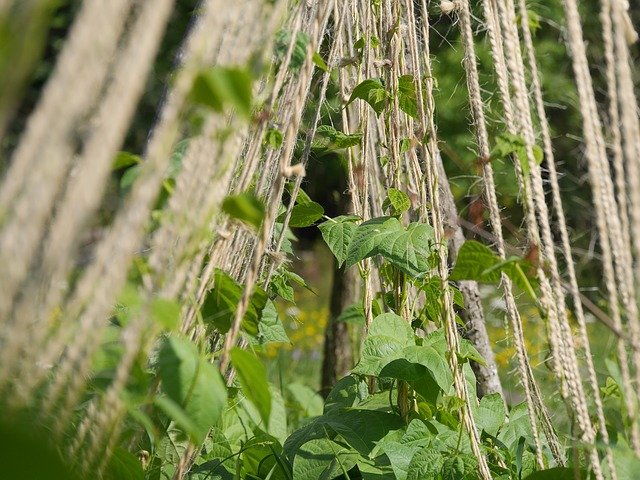
Within these two varieties, most of the care remains the same, with the exception of support for pole beans. There are many common types of beans that fall into one of these two categories.
Snap beans, formerly called string beans, are perhaps the most common. These green beans are eaten whole, and produce a snap when broken in half— hence their name. They have been bred to remove the tough, stringy shell that gave them the name of string beans.
Lima beans are beans which are grown not for the shell, but for their immature seeds, which are shelled and eaten.
Lastly, you have beans that are eaten for their mature seeds. This includes varieties like blackeye peas— which, yes, are beans and not really peas! And of course, while often called green beans, there are many varieties that produce purple, yellow, and even red shells.
Quick Guide to Planting Beans
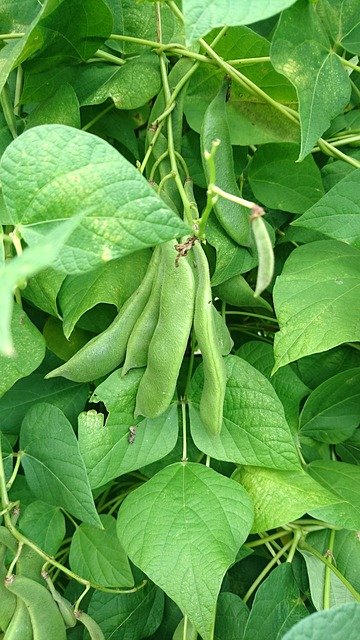
- Sow bean seeds (bush or pole) in the ground any time after the danger of frost has passed for the year. Once the soil reaches at least 50 degrees Fahrenheit (10°C), you can start planting.
- Choose a spot that gets full sunlight, and make sure the soil pH is between 6.0 and 6.8.
- Plant your seeds ¼ inches (25 mm) deep in heavy, well-draining soil.
- For bush beans, plant seeds 2-4 inches (5-10cm) apart, and keep rows 2-3 feet (60-90cm) apart.
- For pole beans, sow seeds 6-10 inches (15-25 cm) apart and keep rows 3-4 feet (90-120cm) apart. Make sure to provide them support such as this trellis here. Or you might like to check out our DIY Trellis here.
- Beans do not require additional fertilizer, but make sure they get plenty of water. At least an inch of water a week is necessary when the weather is warm. Make sure to water in the morning so the soil dries out throughout the day.
- Beans do best when in air temperatures between 65 and 85 degrees Fahrenheit (18-30° C).
- There’s no need to start beans early indoors, as they grow very quickly, and their fragile roots don’t like being transplanted.
- Beans are typically ready to harvest after 50 to 60 days.
Ideal Growing Conditions for Beans
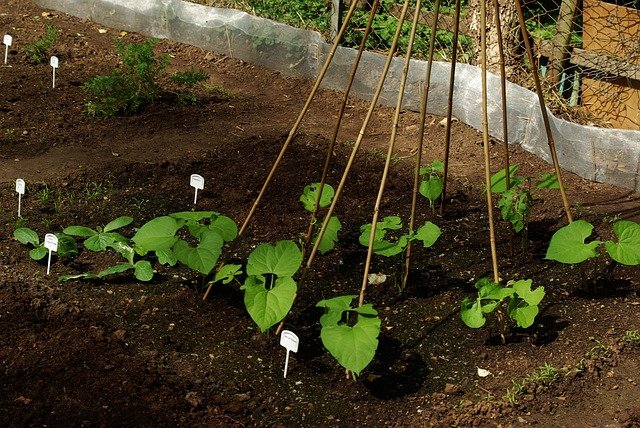
Beans grow best in spring or early summer, as they prefer more moderate temperatures. A range between 65-85°F (18-30°C) is what’s best for them. They don’t tolerate cold well, but they can grow in hotter temperatures if already established.
Beans have shallow and very fragile roots that need to be cared for. A heavy but well-draining soil is best, with a pH between 6.0 and 6.8. Well-draining soil is vital: if their roots sit in water, they may start to rot, but the plants need a lot of water to thrive. Mulching the soil will help with this, and help keep the roots cool.
It is also important to keep weeds out of the area, but weed carefully to avoid disturbing the roots. Typically beans don’t need fertilizer, but adding some compost after they start flowering can help them produce more. Avoid too much nitrogen, as this will encourage them to grow more foliage instead of pods.
Choose a spot that gets at least 8 hours of direct sunlight every day, as beans need sun to thrive. They also need a lot of water: at least 1-2 inches a week. But again, water them in the morning and make sure the soil dries out— you don’t want the roots sitting in water for very long.
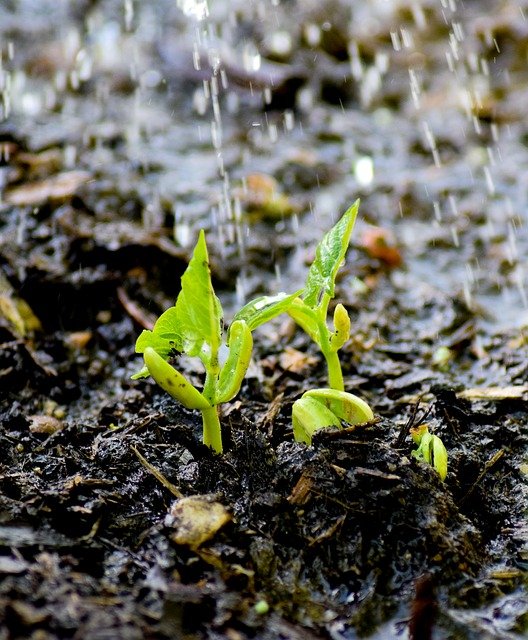
Lastly, if you have pole beans, prune and cut back when necessary. If the plant reaches the top of the support, cut it off to encourage it to focus on producing more pods.
Growing Beans From Seed
Growing green beans from seed is actually very easy, and the best way to grow beans. Because of their fragile roots, beans don’t take well to being transplanted, so it is best to sow your seeds right where you want the plants to grow. However, if you prefer to grow in pots first, this is ok too, you will just have to be extra careful when transplanting them out into the garden.
Beans tend to germinate very well, so you should expect a high success rate. Make sure to keep the young plants moist, and avoid excessive heat— if the temperature is climbing above 85°F (30°C), you may want to find a way to protect your young seedlings such as with shade cloth. Some gardeners even set up an umbrella to protect seedlings on particularly warm days.
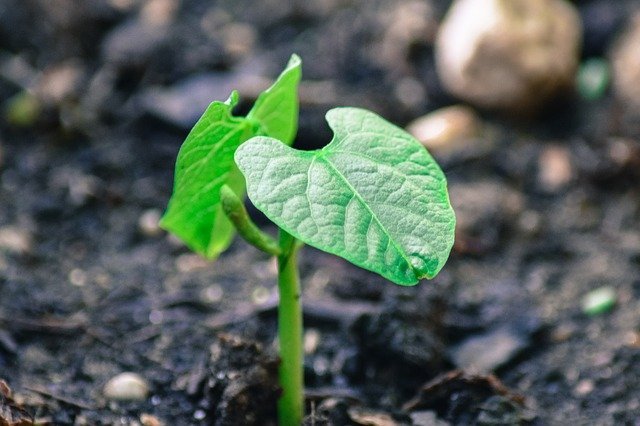
Beans mature very quickly and can go from seed to 6 inches (15cm) tall in only 1 or 2 weeks. So there is really no need to start them indoors, however, if you really want that extra week or two you would get from starting them indoors, plant the beans in biodegradable pots. Then, when you’re ready to put them in the ground, put the whole pot in. This prevents the roots from being disturbed and leads to more success.
Lastly, make sure to protect young plants from animals like deer and rabbits. Rabbits especially find young bean leaves tasty, so keep them away from your bean seedlings.
Companion Planting
Beans are one of the most common plants for companion planting. If you don’t know what that is, it is the art and science of planting multiple plants together, so that they each benefit from each other and grow better. The most common example is the Native American trio of beans, corn, and squash.
Companion planting is about balancing the root space, soil needs, nutritional needs, and pest possibilities of plants. Here are some plants that work well with beans:
- Corn
- Rosemary
- Cucumber
- Eggplant
- Broccoli
- Celery
- Squash (including pumpkin and zucchini)
- Kale
- Lettuce
- Tomatoes
- Strawberries
- Swiss Chard
- Nasturtium
Other plants can be grown with beans as well, but these are some of the most common.
Beans Are Self-Pollinating
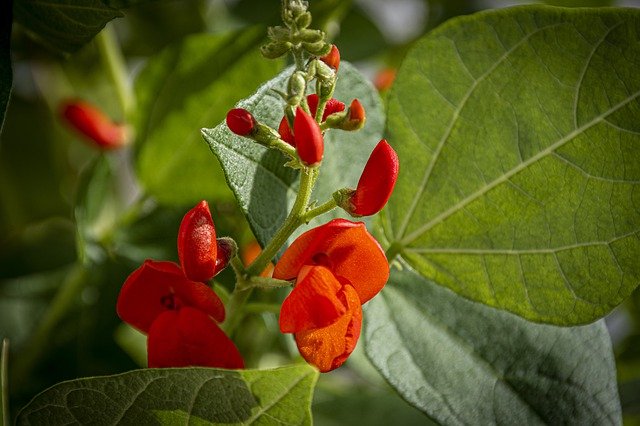
Because beans are self-pollinating, they don’t require bees or other insects in order to produce beans. The flowers release pollen the night before they open, then as they open, pollination occurs and the flower forms the bean.
Harvesting and Storing Beans
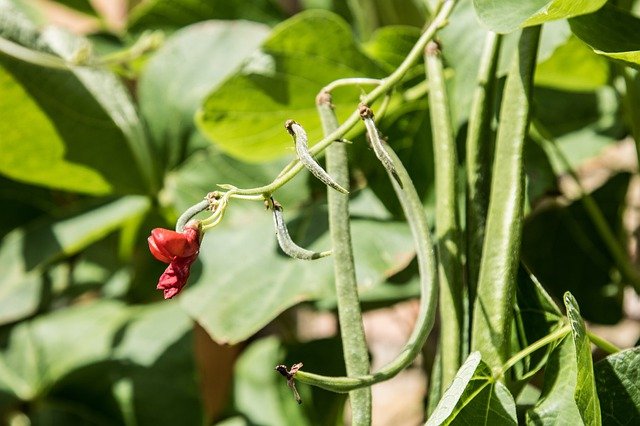
Bush beans are ready to harvest after 50 to 60 days; pole varieties may take up to 90 days, but produce more often over a longer period of time. If you harvest properly, you can keep your plant producing more beans for a good length of time.
For snap beans or similar varieties, pick the beans when the pods are at least 3 inches (7.5cm) long, and before the beans inside start to become fully round and plump. You want the nice snap without the seeds becoming too mature; once this happens, the plant may stop producing new growth.
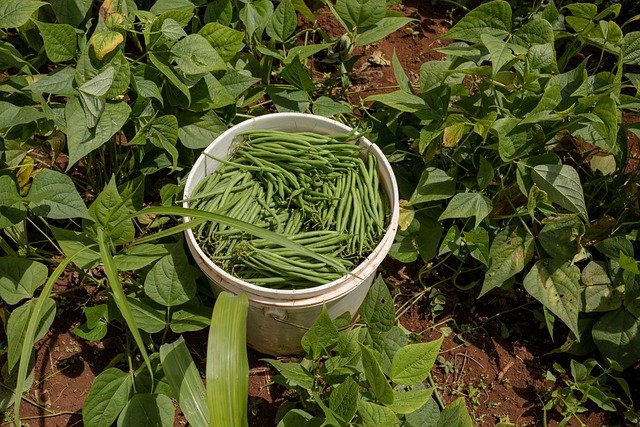
For other varieties of beans, you may want to wait until the seeds are a bit more mature. This depends on the type of bean and your own wants, so make sure you know the needs of your specific variety.
Once harvested, beans can be cleaned and then eaten right away or stored. Unshelled beans can stay good in the fridge for a week. Once beans are shelled, they can be frozen and stay good for up to 3 months.
Of course, beans taste best when fresh, and are a great addition to salads, meat dishes, and many other meals. This recipe for Roasted Parmesan Green Beans is a delicious way to use your fresh green beans!
Pests and Disease
As with any plant, beans can be bothered by pests and diseases. The good news is that beans, especially pole beans, are fairly hardy, and most often can survive on their own. But here are some common pest and disease problems, and what you can do to help prevent them.
- Aphids, mites, and similar insects may take up residence on the leaves; luckily, a good spray from the hose can usually take care of them. If you notice nests, egg sacs, or heavy infections on specific leaves, remove them immediately.
- Powdery mildew can easily be treated with this DIY milk spray.
- Keep the garden weed-free, as these can bring unwanted diseases.
- Misting beans with compost tea can help keep fungal problems away.
Growing Beans FAQ
Here are some common questions, and their answers, you may have about growing beans.
- Can I grow beans in a pot? You can grow beans in a pot or container. Beans have shallow roots, so they don’t need a lot of ground space. However, pole varieties need a lot of support that can be difficult to provide in pots. Additionally, it is vital to keep the soil well-drained and prevent too much water buildup.
So for growing beans in pots or containers, consider a bush variety of bean.
- Can I grow beans inside? You can grow beans inside, but it will be much harder than growing them outdoors. Because they grow so fast, growing them outside will be easy. But if you can’t do that, they can be grown indoors. Make sure you give them all of the requirements listed above, and if you can’t fit large trellises inside, bush varieties may be better. Remember beans need at least 8 hours of direct sunlight; you may need to get grow lights to grow beans indoors. You can read more on How to Start Vegetable Seedlings Under Grow Lights here.
- Why aren’t my beans germinating? The most common reason beans don’t germinate is because of soil temperature: if the soil is below 50°F (10°C) or outside temps of below 65° F (18°C), they probably won’t germinate. Make sure your soil is warm enough for your beans.
Growing Delicious Beans
Beans, especially snap beans, are a great addition to your garden. They can grow with many other plants, are easy to care for, and produce lots of delectable crop. Plus, if you have pets, many small animals also enjoy getting green beans as a treat!
With adequate sunlight, water, and well-draining soil, you can have success with growing beans. And nothing beats how good they taste fresh from the garden!
Recommended Products
Further Reading:
- 7 Reasons Why Your Green Bean Plants Are Turning Yellow
- How To Grow Sugar Snap Peas: Growing Guide And Tips
- DIY Trellis For Cucumbers (Step-By-Step With Pictures)
- Why Is My Spinach Flowering? Causes and Solutions
